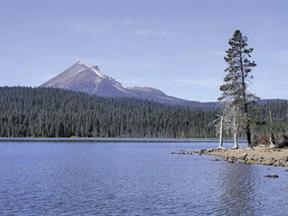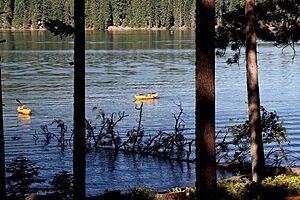Lake of the Woods (Oregon) facts for kids
Quick facts for kids Lake of the Woods |
|
|---|---|

Mount McLoughlin beyond Lake of the Woods
|
|
| Location | Klamath County, Oregon, USA |
| Coordinates | 42°22′09″N 122°12′57″W / 42.36930°N 122.21570°W |
| Type | Natural |
| Catchment area | 26 square miles (67 km2) |
| Max. length | 2.75 mi (4.43 km) |
| Max. width | 3⁄4 mi (1.2 km) |
| Surface area | 1,146 acres (464 ha) |
| Average depth | 27 ft (8.2 m) |
| Max. depth | 55 ft (17 m) |
| Surface elevation | 4,949 ft (1,508 m) |
Lake of the Woods is a beautiful natural lake in southern Oregon, United States. It's nestled high up in the Cascade Range mountains, within the Fremont–Winema National Forest. This lake covers about 1,146 acres. It got its name in 1870 from Oliver C. Applegate. Today, the Oregon Department of Fish and Wildlife helps take care of the fish in the lake. A small community called Lake of the Woods is on the lake's east side. It's a very popular spot for outdoor fun in southern Oregon.
Contents
Discovering Lake of the Woods History
Lake of the Woods was named by Oliver C. Applegate in 1870. He was building a road nearby at the time. Applegate also built a cabin, becoming the first person to live there.
The lake area became part of the Cascade Forest Reserve in 1898. Later, in 1908, it moved to the Crater National Forest. The United States Forest Service started allowing people to build homes there in 1916.
In 1920, the Forest Service built a public campground by the lake. It was very popular, with 1,850 visitors in its first year. More campgrounds were added in 1923 as more people visited. In 1926, a company was allowed to build a resort at the lake.
In 1932, Lake of the Woods became part of the Rogue River National Forest. In the 1930s, the Civilian Conservation Corps built offices and homes at the Lake of the Woods Ranger Station. They also made the roads around the lake better.
By 1937, there were 120 summer homes around the lake. Electricity arrived in 1938. By 1948, there were 200 summer homes and four summer camps. The resort burned down in 1951 but was quickly rebuilt. More and more people visited, sometimes up to 5,000 on weekends. In 1958, Oregon Route 140 was finished, making it easier to reach the lake.
In 1961, the lake joined the new Winema National Forest. This forest later combined with the Fremont National Forest in 2002. Today, Lake of the Woods is still a favorite spot for fun. The Klamath Ranger District manages the lake and forest. The Oregon Department of Fish and Wildlife manages the fish.
Lake of the Woods Environment
Lake of the Woods is a natural lake covering about 1,146 acres. It is about 2.75 miles long and 0.75 miles wide. The lake is usually 27 feet deep, but can be up to 55 feet deep. The water level changes only about 2 feet in a normal year.
In summer, the surface water warms to about 70°F (20°C). The lake freezes in winter. The bottom of the lake is mostly made of plant and animal remains, sand, and rocks.
Scientists have studied the lake's water quality many times. They check things like depth, temperature, and how clear the water is. These studies show that the lake's environment is doing well, even with many visitors.
To keep the water clean, the Forest Service has taken steps since the 1990s. They closed some roads and improved road drainage. They also teach people about protecting the soil. Cabin owners are encouraged to update their septic systems. The Forest Service also asks people to use soaps that are low in phosphate.
When studies showed that motorboats were causing the shoreline to wear away, the Forest Service acted. They asked cabin owners to plant native plants along the shore. They also stopped people from removing fallen trees from the shoreline. These actions have helped protect the lake's water and shore.
Lake of the Woods Wildlife and Fish
The lake's water quality is good, meaning it has enough oxygen for fish and other life. It's hard to know exactly which fish were originally in the lake. This is because people started adding fish a long time ago.
Some studies suggest that rainbow trout and tui chub might have been native. Another study thinks that only the Great Basin redband trout was originally from the lake.
The lake was first stocked with fish in 1913, adding hatchery-raised rainbow trout. This led to good fishing for about ten years. In 1922, the Oregon State Game Commission added many other fish. These included largemouth bass, black crappie, bluegill, and yellow perch. The yellow perch quickly became the most common fish.
More types of trout and salmon were added between 1925 and 1935. But the trout and salmon numbers started to drop around 1938. This was likely due to competition from the warm-water fish. In 1955, all the fish in the lake were removed. Then, the lake was restocked with rainbow trout, brook trout, and kokanee salmon.
Today, the Oregon Department of Fish and Wildlife manages the lake's fish. They use both natural breeding and stocking to keep fish populations healthy. Some fish, like brook trout and yellow perch, have healthy populations on their own. Others, like kokanee salmon and rainbow trout, are added by stocking. Kokanee salmon caught here are usually about 12 inches long. Brown trout are 14 to 19 inches, and most rainbow trout are about 10 inches.
The lake is also home to many kinds of birds. You can see grebes, ducks, geese, and sometimes common loons. Birds of prey like osprey and bald eagles also visit. The forest around the lake has many songbirds and different types of owls.
The forest around Lake of the Woods has many mammals. Large animals include mule deer, black-tailed deer, elks, black bears, and coyotes. Smaller animals like porcupines, skunks, and squirrels also live here.
Each June, the Forest Service hosts a program for high school students at the lake. Students learn about geology, forestry, and wildlife. They also learn about managing recreation and controlling wildfires. It's a great way to learn about nature while enjoying the outdoors.
Fun Activities at Lake of the Woods
Lake of the Woods is a very popular place for recreation. There are 218 summer homes around the lake. These homes need permits from the Forest Service. There are also two campgrounds with 124 campsites. Aspen Point has 60 campsites, and Sunset has 64.
You can also find two areas for swimming and picnicking. There are three camps for groups near the lake. A resort is open most of the year. It has two restaurants, a general store, a marina for boat rentals, and 32 cabins to rent.
In summer, people love to swim, fish, canoe, boat, and water ski. There are also trails for hiking, biking, and horseback riding. In winter, people enjoy ice fishing.
In 1998, about 320,000 people visited the lake for recreation. The nearby Great Meadows area is popular in winter for snowmobile riding and cross-country skiing.
The Lake of the Woods Resort is open for 11 months, closing only in April. It has 32 cabins and spots for 22 RVs. Since 2011, the resort also manages the Forest Service campgrounds. The main lodge has a restaurant, store, and gift shop. The resort offers a marina with boat launches, rentals, and fuel. There's also a car service station.
Where is Lake of the Woods?
Lake of the Woods is located high in the Cascade Mountains. It is in western Klamath County, Oregon. The lake sits at 4,949 feet above sea level. The Fremont–Winema National Forest surrounds it.
The lake is about 33 miles west of Klamath Falls. It is also 43 miles east of Medford. The small community of Lake of the Woods, Oregon is on the east shore. It is about half a mile south of Oregon Route 140. There is a Forest Service visitor center at the historic Lake of the Woods Ranger Station. It's at the north end of the lake, right off Route 140, and is open during the summer.





